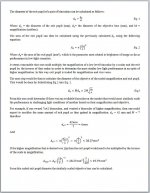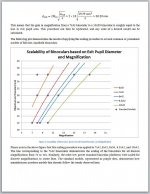Quincy88,
As others have pointed out, depending on the task and the lighting conditions, different figures of merit apply. And of course there are all the other constraints when comparing e.g., similar quality of instruments, vision of observer, entrance pupil of observer >= exit pupil of instrument, etc.
However, I am sorry to be dense, but it seems to me that your scaling factor has the wrong sensitivity with respect to aperture and magnification compared with my experience and most other figures of merit. Let me try to explain. Let A be aperture or objective size and let M be magnification. The binoculars on each of your curves have the same value of A^2/M. I'll call this your derived figure of merit or scaling factor. Other common figures of merit or performance figures are
- A/M or exit pupil
- (M*A)^1/2 or twilight factor
- M*A or Bishop figure
- M*A^1/2 or Adler figure
The Bishop figure and Adler figure are more commonly used in astronomy and the Bishop figure is obviously just the square root of the twilight factor common in binocular advertising. I find that Adler figure most closely agrees with my experience using binoculars for astronomy.
Looking at the sequence from your figure to the Adler figure, you give the most emphasis to aperture relative to magnification and Adler gives the least emphasis to aperture relative to magnification. Three binoculars I have used extensively for astronomy are 7x50, 10x30, and 15x45. All three are of reasonably high quality. The 10x and 15x are image stabilized but for testing and comparison at night I used all three tripod mounted.
If I use your figure for the three I get 50^2/7=357 for the 7x50, 45^2/15=135 for the 15x45, and 30^2/10=90 for the 10x30. so the expectation would be that the 7x50 would be vastly superior with the other two lagging behind but the 15x45 better than the 10x30.
Using the Adler figure I get 7*50^1/2=50 for the 7x50, 15*45^1/2=101 for the 15x45 and 10*30^1/2=55 for the 10x30. When I tested the binoculars under dark skies I found that the 10x30 performs as well as the 7x50 and the 15x45 is vastly superior. I judged this both by the faintest stars I could detect and by the detail I could see in deep sky objects.
In other words, I can give up exit pupil at higher magnification and increase what I can see. Further, the advantage I gain from more magnification increases faster than the penalty I pay for smaller exit pupil. That's why the Adler figure is a better representation than the Bishop or twilight figure. Of course if I can use a larger aperture and more magnification that is even better, but then there are other issues like mounting, portability, field of view, etc.
Again, perhaps my astronomy experience is unrelated to the low light scaling you are considering. And if I am misinterpreting your math or intent I apologize.
Alan







